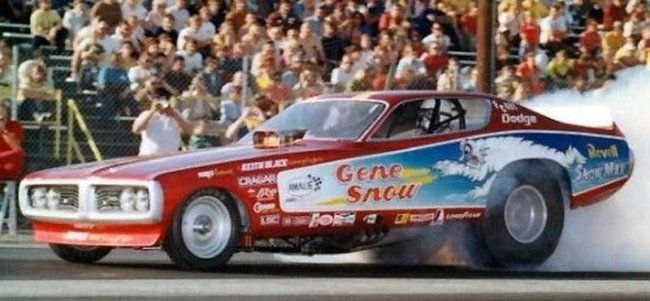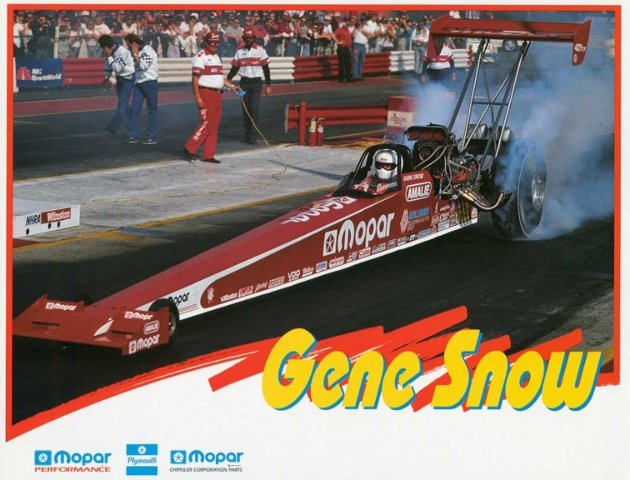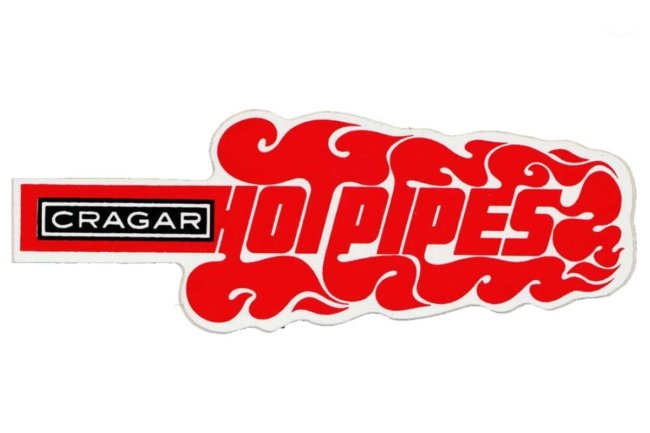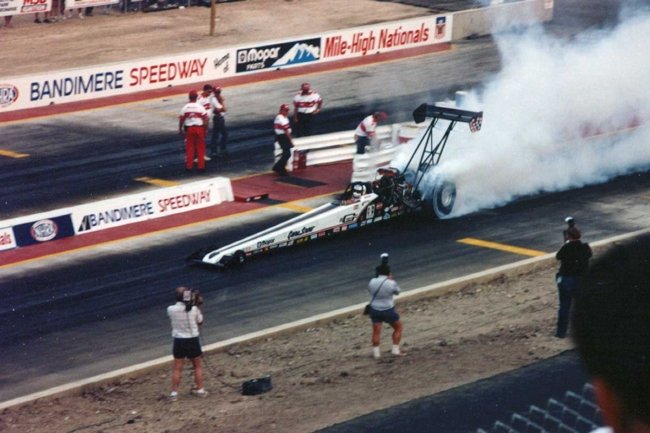
Gene Snow was a legendary figure in the world of drag racing. He began his career in the early 1960s, initially competing in the Funny Car category. As displayed in its April 1972 Hot Rod magazine advertisement, Snow relied on Cragar’s “Hot Pipes” to power his Mopars.
Above Left: Gene Snow became one of many heavy hitters in the nitro fuel ranks to switch to Cragar in the early 1970s. The 1972 Hot Rod magazine advertisement discusses the benefits of Cragar headers, which were available from the mid-1960s until the early 1980s. Above Right: Cragar’s Hot Blue headers were an equal-length design developed for maximum performance.
Snow’s journey was a testament to the power of resilience and determination. Despite the challenges, his innovative approach to drag racing and unwavering perseverance gained recognition. Throughout his career, he achieved numerous victories, set multiple records, and earned a reputation as one of the sport’s most formidable competitors in Funny Car and later in Top Fuel eliminator.
In 1969, Snow officially became the first Funny Car driver to break the 200-mph barrier in the quarter mile. He dominated throughout 1970, securing wins at significant events, including the National Hot Rod Association (NHRA) York, PA event, the inaugural Supernationals, and three American Hot Rod Association (AHRA) events. He capped the season with an AHRA championship in his Dodge Challenger.

Above: Gene Snow’s iconic ‘Snow Man’ mini-Charger, a testament to his racing prowess, became a household name. After a successful stint under the Rambunctious banner, the addition of Revell plastic model company sponsorship necessitated a name change, underscoring the pivotal role of sponsorships in the world of racing. (Photographer Unknown)
By 1971, he added Jake Johnston to form a two-car team. Snow won the Super Stock Magazine Championships in York, Pa., won the OCIR All-Pro Series race, and was named Drag News Driver of the Year.
Snow’s initial Funny Cars ran under the “Rambunctious” moniker, which became synonymous with his early racing legacy. Snow’s “Rambunctious” Mopars were known for their distinctive appearance and high-performance capabilities, contributing to Snow’s success on the drag strip.
Like many drag racers in the early 1970s, Snow was sponsored by the Revell model company. The sponsorship provided financial support but required a name change for his cars, a significant shift in his racing identity. Snow was no longer known as “Rambunctious” but rather “the Snow Man.” The name stuck, and even after the Revell sponsorship ended, he was still known as the Snow Man.
Above: After great success in the late 1960s and 1970, Gene Snow added Jake Johnston in 1971, which made for a one-two punch against the competitors. Snow ran the red car, and Johnston ran the blue car. A two-car team also increased the number of match races the team could book for the season. (Photographers Unknown)
After retiring from professional racing, Snow remained involved, offering mentorship and support to up-and-coming racers. Snow’s remarkable career and achievements cemented his status as one of drag racing’s most iconic figures, earning him a place in the sport’s Hall of Fame.
Revell is a well-known manufacturer of plastic scale model kits based in the United States. It was founded in 1943 by Lewis H. Glaser, an entrepreneur who initially started the company manufacturing wooden toys in Venice, California.
Above: Snow ran a series of Mopars under the Rambunctious moniker early on. Snow’s Mopars were always well-equipped, running the best parts, and plenty of attention was paid to the car’s appearance. (Photographers Unknown)
In the late 1940s, Revell shifted its focus to plastic models, capitalizing on the growing popularity of plastic as a modeling material due to its affordability and versatility. Revell became renowned for producing high-quality plastic model kits of various subjects, including airplanes, cars, ships, and spacecraft. The company’s kits were known for their accuracy, detail, and innovative engineering, making them popular among hobbyists of all ages.

Above: After a hiatus from the sport, Snow returned with a series of unsponsored top-fuel dragsters. Because of his success, Snow caught the eye of Mopar officials. He parlayed his performance as an independent into a lucrative sponsorship.
Over the years, Revell released numerous iconic model kits that became staples of the hobbyist modeling community, including multiple drag race vehicles. Revell underwent several ownership changes and corporate restructurings over the years. In 2018, Revell filed for bankruptcy, but its assets were subsequently acquired by a German investment firm, Quantum Capital Partners, ensuring the continuation of the brand.
Above Left: Revell immortalized the Snow Man with a 1/16-scale plastic model of his Charger. The big model was highly detailed and a success for Revell. Above Right: For the less experienced model builder, Revell introduced the same Charger in a minimally detailed 1/25-scale model. Revell made several models of Snow’s funny cars running Chevy bodies, but the Mopars were and still are the most popular.
Cragar Wheels has a rich history in the automotive aftermarket industry. It was founded in 1930 by Crane Gartz. The company’s name is a six-letter combination of Gartz’s first name, CRA, and last name, GAR, hence the name “Cragar.”
Initially, the company focused on producing innovative equipment for race cars and hot rods. Cragar gained significant popularity in the 1960s and 1970s, particularly with its iconic “Cragar S/S” wheels. These wheels were in high demand due to their chrome-plated spokes with a central cap configuration, which not only enhanced the performance of the vehicles but also added a stylish touch.
Above: Cragar’s Hot Pipes were never as popular as Hooker or Hedman, but they were highly regarded by those that installed them on their Mopars. The Hot Pipes in the box were manufactured on 12/28/78 and are for a big-block Dodge Van. Included with the headers were a pair of cool stickers.
The popularity of Cragar S/S wheels was broader than just the racing scene. These wheels became a symbol of American muscle cars, such as the Chevrolet Camaro, Ford Mustang, and Dodge Charger, thereby significantly influencing the automotive industry and capturing the hearts of enthusiasts. Cragar expanded its line to include headers, safety helmets, and ignition products.
Despite the automotive industry’s ever-changing landscape, Cragar has stood the test of time, maintaining its status as an iconic brand in the aftermarket wheel industry. The classic Cragar S/S design, a symbol of American muscle cars, remains popular among collectors, restoration enthusiasts, and custom car builders. It reflects the brand’s enduring legacy and cultural impact, which inspires admiration and connection.

Above: Although Cragar may have expanded its catalog to include ignitions, headers, and safety equipment through the 1980s, it is still best known for its iconic Cragar S/S wheel. The wheel was the go-to aftermarket wheel for muscle car-era vehicles, and although Cragar and other wheel manufacturers have introduced more modern wheels, the S/S is still the staple of ’60s and ’70s hot-rodded cars that attend local car events.
Today, Cragar continues to produce a variety of wheels and automotive accessories, including classic designs that pay homage to its rich history and innovative products that cater to the evolving needs of vehicle enthusiasts. Its diverse offerings reflect the brand’s commitment to quality, innovation, and enduring legacy, and those offerings can be found at Classic Industries.



















 Mopar Connection Magazine – The ONLY Daily Mopar Magazine © 2022. All Rights Reserved. Mopar Connection Magazine is the ONLY daily Mopar Magazine bringing you the latest Mopar news, technology, breaking news, and Mopar related events and articles. Find out the latest information about Mopar, Mopar products and services, stay up to date on Mopar enthusiast news, dealership information and the latest Mopar social media buzz! Sign up for the Mopar Connection Magazine newsletter for the latest information about new products, services and industry chatter. Mopar Connection Magazine is the best and only source you need to be a Mopar industry insider!
Mopar Connection Magazine – The ONLY Daily Mopar Magazine © 2022. All Rights Reserved. Mopar Connection Magazine is the ONLY daily Mopar Magazine bringing you the latest Mopar news, technology, breaking news, and Mopar related events and articles. Find out the latest information about Mopar, Mopar products and services, stay up to date on Mopar enthusiast news, dealership information and the latest Mopar social media buzz! Sign up for the Mopar Connection Magazine newsletter for the latest information about new products, services and industry chatter. Mopar Connection Magazine is the best and only source you need to be a Mopar industry insider! by
by